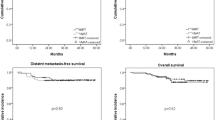Abstract
Purpose
To analyze quality of life (QoL) and functional state (FS) by patient-reported outcome (PRO) questionnaires (FACT-G, FACT-NP, PSS-HN, XeQOLS, and EQ-5D-3L) in long-term survivors nasopharyngeal carcinoma (NPC) treated with conventional radiotherapy (RT) and intensity modulated radiotherapy (IMRT).
Methods
25 patients answered to five questionnaires about QoL and FS. All patients were assessed also for late toxicity.
Results
Functional Assessment of Cancer Therapy-General (FACT-G) and Performance Status Scale Head and Neck (PSS-HN) scores were significantly elevated (better QoL) in age <50 years (p = 0.03). PSS-HN score was higher in IMRT group. The observed xerostomia was lower in the IMRT group and in patients who received conventional RT had worse QoL according to XeQOLS (University of Michigan Xerostomia-Related Quality of Life Scale) score questionnaire. Lower PSS-HN score and higher XeQOLS score were significantly related with the late xerostomia (p = 0.009 and 0.002, respectively).
Conclusions
Our preliminary data suggest that age, older techniques, xerostomia, and hearing loss are negative predictors of QoL.


Similar content being viewed by others
References
Ferrari D, Codecà C, Bertuzzi C et al (2012) Role of plasma EBV DNA levels in predicting recurrence of nasopharyngeal carcinoma in a western population. BMC Cancer 12:208
Micheli A, Francisci S, Krogh V, Rossi AG, Crosignani P (1999) Cancer prevalence in Italian cancer registry areas: the ITAPREVAL study. ITAPREVAL Working Group. Tumori 85:309–369
Gatta G, Botta L, Sanchez MJ, Anderson LA, Pierannunzio D, Licitra L (2015) EUROCARE Working Group. Prognoses and improvement for head and neck cancers diagnosed in Europe in early 2000s: the EUROCARE-5 population-based study. Eur J Cancer 51:2130–2143
Perri F, Della Vittoria Scarpati G, Buonerba C et al (2013) Combined chemo-radiotherapy in locally advanced nasopharyngeal carcinomas. World J Clin Oncol 4:47–51
Lee AW, Lin JC, Ng WT (2012) Current management of nasopharyngeal cancer. Semin Radiat Oncol 22:233–244
Wu F, Wang R, Lu H et al (2014) Concurrent chemoradiotherapy in locoregionally advanced nasopharyngeal carcinoma: treatment outcomes of a prospective, multicentric clinical study. Radiother Oncol 112:106–111
Klein J, Livergant J, Ringash J (2014) Health related quality of life in head and neck cancer treated with radiation therapy with or without chemotherapy: a systematic review. Oral Oncol 50:254–262
Deleyiannis FW, Weymuller EA Jr, Coltrera MD (1997) Quality of life of disease-free sirvivors of advanced (stage III or IV) oropharyngeal cancer. Head Neck 19:466–473
Cox JD, Stetz J, Pajak TF (1995) Toxicity criteria of the Radiation Therapy Oncology Group (RTOG) and the European Organization for Reserch and Treatment of Cancer (EORTC). Int J Radiat Oncol Biol Phys 31:1341–1346
Cella DF, Tulsky DS, Gray G et al (1993) The Functional Assessment of Cancer therapy scale: development and validation of the general measure. J Clin Oncol 11:570–579
List M, D’Antonio L, Cella DF (1996) The performance status scale for head and neck cancer patients and the functional assessment of cancer therapy-head and neck scale: a study of utility and validity. Cancer 77:2294–2301
EuroQol Group (1990) A new facility for the measurement of health-related quality of life. Health Policy 16:199–208
Tong MC, Lo PS, Wong KH et al (2009) Development and validation of the functional assessment of cancer therapy nasopharyngeal cancer subscale. Head Neck 31:738–747
Eisbruch A, Rhodusb N, Rosenthalc D et al (2003) How should we measure and report radiotherapy-induced xerostomia? Semin Radiat Oncol 13:226–234
Edge S, Byrd DR, Compton CC, Fritz AG, Greene FL, Trotti A (2010) AJCC cancer staging manual, 7th edn. Springer, New York
Bonomi AE, Cella DF, Hahn EA et al (1996) Multilingual translation of the functional assesment of cancer therapy (FACT) quality of life measurement system. Qual Life Res 5:309–320
Henson BS, Inglehart MR, Eisbruch A, Ship JA (2001) Preserved salivary output and xerostomia-related quality of life in head and neck cancer patients receiving parotid-sparing radiotherapy. Oral Oncol 37:84–93
Kularatna S, Whitty JA, Johnson NW, Scuffham PA (2013) Study protocol for valuing EQ-5D-3L and EORTC-8D health states in a representative population sample in Sri Lanka. Health Qual Life Outcomes 11:149
Oskam I, Verdonck-de Leeuw I, Aaronson N, Kuik D et al (2010) Quality of life as predictor of survival: a prospective study on patients treated with combined surgery and radiotherapy for advanced oral and oropharyngeal cancer. Radiother Oncol 97(2):258–262
Fang FM, Tsai WL, Lee TF et al (2010) Multivariate analysis of quality of life outcome for nasopharyngeal carcinoma patients after treatment. Radiother Oncol 97(2):263–269
Miles EA, Clark CH, Urbano MT et al (2005) The impact of introducing intensity modulated radiotherapy into routine clinical practice. Radiother Oncol 77:241–246
Wong FC, Ng AW, Lee VH et al (2010) Whole-field simultaneous integrated-boost intensity-modulated radiotherapy for patients with nasopharyngeal carcinoma. Int J Radiat Oncol Biol Phys 76:138–145
Bian X, Song T, Wu S (2015) Outcomes of xerostomia-related quality of life for nasopharyngeal carcinoma treated by IMRT: based on the EORTC QLQ-C30 and H&N35 questionnaires. Expert Rev Anticancer Ther 15:109–119
Tsai WL, Huang TL, Liao KC, Chuang HC, Lin YT, Lee TF et al (2014) Impact of late toxicities on quality of life for survivors of nasopharyngeal carcinoma. BMC Cancer 14:856
Author information
Authors and Affiliations
Corresponding author
Ethics declarations
Ethical standards
This article does not contain any studies with human participants or animals performed by any of the authors.
Conflict of interest
The authors declare that they have no conflict of interest. This study was conducted in accordance with the Declaration of Helsinki. Informed consent was obtained from all individual participants included in the study.
Rights and permissions
About this article
Cite this article
Lastrucci, L., Bertocci, S., Bini, V. et al. Late toxicity, evolving radiotherapy techniques, and quality of life in nasopharyngeal carcinoma. Radiol med 122, 303–308 (2017). https://doi.org/10.1007/s11547-016-0722-6
Received:
Accepted:
Published:
Issue Date:
DOI: https://doi.org/10.1007/s11547-016-0722-6



